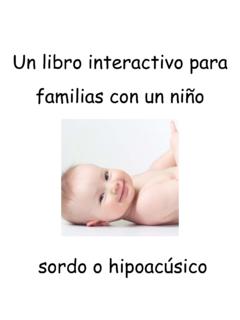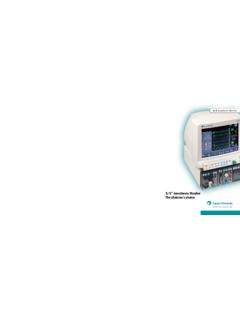Transcription of Guide for Families of Infants & Children with Hearing Loss ...
1 2008 with early detection,Early Intervention can begin! Guide for familiesof Infants and Children with Hearing lossBirth to 3 Geneva Marie Durgin was born January 20, 2007. She lives in Wilder, Vermont with her parents Christian and Jennifer. At six weeks old Geneva was diagnosed as profoundly deaf, after not passing two newborn screenings. She laughs and smiles easily, is very social, and loves making noises. Cover photograph 2008 This edition of the Resource Guide was made possible by the participation and support of members from: Children with Special Health Needs Hearing Advisory Council Early Hearing Detection and Intervention Program Hearing Outreach Program Vermont Center for the Deaf and Hard of Hearing Parent infant Program The Family, infant and Toddler Program Thanks also to the Center on Disability and Community Inclusion/UCEDD at the University of Vermont for assistance with design and a child diagnosed with Hearing loss can be overwhelming.
2 This booklet attempts to provide some basic information to help Families understand Hearing loss and to learn about the support and services that are available to of the information will be further explained to you by your parent advisor who will help you navigate this maze of new information. CONTENTSA udiological Information and Explanation 4 Communication 10 Communication Options and Resources 12 Early Intervention in Vermont 14 Internet Resources 16 Glossary 17 An audiologist is a professional with a master s or doctoral degree in Hearing health care. The audiologist performs many different types of tests to determine the type and degree of Hearing in each ear. Information about speech, language, and Hearing development are also provided. Hearing aids and other assistive listening devices may be a part of your child s treatment. What is an Audiogram?An audiogram is a graph that shows the intensity (loudness) that your child hears at various frequencies (pitches).
3 What can my child s Audiogram tell me? What can my child hear? (sounds and volume) What speech sounds is my child missing? Do both ears have Hearing loss ? Is the Hearing loss the same in both ears? Is the Hearing loss the same at all frequencies (pitches)?Your audiologist and parent advisor can provide more infor-mation about these and any other questions you may have. What is an Audiologist? What are the degrees of Hearing loss ?Loudness is measured in decibels (dB). Decibels on an audiogram are called Hearing level or threshold. Minimal/Slight 16 25 dB(also called borderline normal)Mild 26 40 dB Moderate 41 55 dBModerate-Severe 56 70 dBSevere 71 90 dBProfound 91+ dBDegrees of Hearing loss A sensorineural Hearing loss is a problem with the inner ear or auditory ( Hearing ) nerve. This type of loss is permanent. The degree for this type of Hearing loss can be mild to conductive Hearing loss is a problem with the outer and/or middle ear.
4 This makes it difficult for sound to travel to the auditory nerve. Most of the time a doctor can treat this type of loss with medicine or surgery. The degree for this type of Hearing loss can be mild to mixed Hearing loss is a combination of sensorineural and conductive Hearing loss . A unilateral Hearing loss is a Hearing loss of any type and degree in one ear, and normal Hearing in the other bilateral Hearing loss is some type and degree of Hearing loss in both ears. The loss may be the same type and degree in both ears or different. What are the different types of Hearing loss ? Name: Date of test:Use the below blank audiogram to chart your child s Hearing . A check list is also provided on the next page, to document your child s Hearing in numbers, called Frequency (Hz), along the top of the audiogram, represent the pitch being tested. The audiogram displays low pitches to high pitches from left to right. The numbers, called decibels (dB), along the left side of the audiogram, represent loudness.
5 The audiogram displays soft to loud going down the side of the audiogram. The decibel (dB) that your child responds to at each frequency is their Hearing Level or Threshold for that child s Hearing loss -100102030405060708090100110120125 250 500 1000 2000 4000 8000 Hearing Level (dB)Frequency (Hz)8 Right Ear Left EarType: Sensorineural Sensorineural Conductive ConductiveMixed Mixed Undetermined UndeterminedDegree:Borderline Borderline Mild MildMild-Moderate Mild-ModerateModerate ModerateModerate-Severe Moderate-SevereSevere SevereSevere-Profound Severe-ProfoundProfound ProfoundUndetermined Un-determinedOther My child s Hearing loss NOTES 0 Children s language development is one of the major accom-plishments in the first three years of life. In this short span of time, Children move from communicating needs nonverbally through facial expressions, gestures, body movements and crying to expressing themselves through speech and/or sign language.
6 How will I communicate with my child? is often one of the first questions parents ask after they discover their child has a Hearing loss . While this is a question only each individual fam-ily can answer for themselves, it is often the most challenging because parents usually know very little about the options available to them. There are three important things to do when making a decision about communication. Become knowledgeable about each option so you can make an educated decision. Choose an option that feels right for your family as no two Children or Families are alike. Remember that if after trying an option and monitoring yours and your child s progress you feel that it is not working or doesn t feel right, you can Schwartz, Sue (1996). Choices in Deafness, A Parent s Guide to Communication Options, Second Edition, Woodbine site: resources for parentsIn a very short amount of time you can become familiar with your choices.
7 The following page has a short summary of the options available to you, as well as a list of resources. Keep in mind that all choices have variations so the information is not all inclusive. Your parent advisor can provide more detailed information. It might be helpful to talk with other parents about their choices as well as people who use them. Visiting programs is another way to become familiar with the options. 2 auditory ORALThis method teaches Children to listen and uses visual cues and speechreading/lipreading. auditory VERBAL This method focuses on the child s Hearing and listening skills. It does not encourage using visual this approach Children learn American Sign Lan-guage, the visual gestural language of the Deaf Commu-nity. They also learn English through reading and writing and may learn spoken English. They learn about Deafculture as well as their family and community SPEECHThis method uses eight handshapes that represent sounds to make spoken language clear through COMMUNICATIONThis method may use any combinations of communicat-ing to help the child with a Hearing loss learn language.
8 One might use signs, speech, amplification and other communication strategies in SUPPORTED SPEECHThis method uses spoken language with signs as a support. Typically, key words in the sentence are signed in an attempt to match and clarify the spoken OptionsYour parent advisor will spend some time with you explaining the various communication options. Below is a list of these options and a brief explanation. Communication , D., (1984). Early Intervention for Hearing Impaired Children : Oral Options, San Diego: College Hill , W., (1994). auditory -Verbal Therapy for Parents andProfessionals, Washington, DC: , Shawn Neal, (1995). Educating Deaf Children Bilingually Pre-College Programs, Gallaudet , , and Daisey, , (1992). The Cued Speech Resource Book for Parents of Deaf Children , Raleigh, NC: National Cued Speech , Sue , (1996). Choices in Deafness, A Parent s Guide to Communication Options, Second Edition, Woodbine House. Children under three years of age with identified Hearing loss are among those eligible to receive services through the state s Early Intervention program.
9 Early intervention services are designed to meet the needs of your child and your family. These services may take place in your home and/or in your community. Why is Early Intervention important?The first few years of life are generally recognized as a critical period for language learning. The focus of Early Intervention is to assist in developing communication and providing access to language. with early detection of Hearing loss , services can begin as soon as possible and there is a better chance that an infant will develop at the same pace as his/her peers. If left undetected, Hearing loss , even in one ear, can result in delays in language acquisition. Research has shown that the nature of cognitive development (ability to think and processinformation) is the same for deaf and Hearing Children . If chil-dren have the opportunity to develop language, they are more likely to reach their are Vermont s Early Intervention Services?Vermont has a number of programs and educational services that are available immediately at no cost to you.
10 The Family, infant and Toddler Program (FITP) provides services for Children birth to three who have special needs. FITP connects Families with service Intervention in Vermont The Vermont Parent infant Program (VTPIP) is one such service provider. VTPIP provides you with the necessary information, support and services needed to better understand your child s Hearing loss and develop his/her communication skills. FITP and VTPIP work in collaboration to develop and imple-ment services for Infants and toddlers who are deaf or hard of Hearing . An Individualized Family Service Plan (IFSP) is written with the family and appropriate service providers. This plan lists all the services and goals that you and your team establish. A family must be enrolled in FITP in order to receive services from a child turns three, services become the responsibility of the local school district. School districts are encouraged to con-nect with the Vermont Center for the Deaf and Hard of Hearing (VCDHH) to access its network of consultants as well as other services and supports available through its organization.







